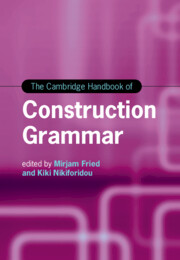Book contents
- The Cambridge Handbook of Construction Grammar
- Cambridge Handbooks in Language and Linguistics
- The Cambridge Handbook of Construction Grammar
- Copyright page
- Contents
- Figures
- Tables
- Contributors
- Acknowledgments
- Construction Grammar
- Part I The Constructional View of Language
- Part II Methodological and Empirical Foundations of Constructional Research
- 6 Frequency
- 7 Corpus Linguistics and the Cognitive/Constructional Endeavor
- 8 Behavioral Evidence and Experimental Methods
- 9 Constructional Networks
- Part III Case Studies in Constructional Morphosyntax
- Part IV Multimodality and Construction Grammar
- Part V Constructions in Sociocultural and Typological Variation
- Part VI Constructional Applications
- Index of Terms
- Index of Languages
- Index of Constructions
- References
8 - Behavioral Evidence and Experimental Methods
from Part II - Methodological and Empirical Foundations of Constructional Research
Published online by Cambridge University Press: 30 January 2025
- The Cambridge Handbook of Construction Grammar
- Cambridge Handbooks in Language and Linguistics
- The Cambridge Handbook of Construction Grammar
- Copyright page
- Contents
- Figures
- Tables
- Contributors
- Acknowledgments
- Construction Grammar
- Part I The Constructional View of Language
- Part II Methodological and Empirical Foundations of Constructional Research
- 6 Frequency
- 7 Corpus Linguistics and the Cognitive/Constructional Endeavor
- 8 Behavioral Evidence and Experimental Methods
- 9 Constructional Networks
- Part III Case Studies in Constructional Morphosyntax
- Part IV Multimodality and Construction Grammar
- Part V Constructions in Sociocultural and Typological Variation
- Part VI Constructional Applications
- Index of Terms
- Index of Languages
- Index of Constructions
- References
Summary
This chapter provides an overview of empirical support for Construction Grammar in the form of behavioral evidence, that is, information derived from the behavior of language users on certain tasks, typically through controlled experiments. Three types of evidence are discussed in particular: (i) evidence from language comprehension tasks that syntactic patternsconvey meaning independently of individual lexical items, (ii) evidence that constructions prime each other both in form and in meaning, and (iii) evidence that grammar consists of a network of related constructions of varying degrees of generality. Many of the cited studies come from the psycholinguistic literature, and even though they were originally not necessarily framed in terms of constructions, their findings are largely in line with the constructional approach. Throughout the discussion, it will be shown how these findings provide evidence for some of the core tenets of Construction Grammar.
Keywords
- Type
- Chapter
- Information
- The Cambridge Handbook of Construction Grammar , pp. 196 - 219Publisher: Cambridge University PressPrint publication year: 2025

